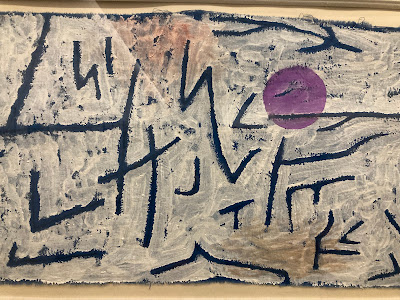Translate
Sunday, July 31, 2022
Kunstmuseum Bern
A few Swiss artists from the Art Museum in Bern Switzerland.
https://www.kunstmuseumbern.ch/en/startseite-englisch-121.html
The artwork there has labels showing history of each piece going back to the artist. The museum probably is very careful with provenance, as it received the bequest of Cornelius Gurlitt on his death in 2014. Lawsuits charging that the Gurlitt family had received artwork stolen by the Nazis got international attention. His gift must have been a mixed blessing for the Kunstmuseum Bern. https://en.wikipedia.org/wiki/Cornelius_Gurlitt_(art_collector)
Ferdinand Hodler (1853-1918), Die Nacht/The Night, 1889
Unknown Artist, The Sexton Attends the Mass for the Dead; 1505. Diptych wood altar.
Johannes Itten (1888-1967), Komposition in Blau/Composition in Blue; 1918
Paul Klee, Ad Parnassum, 1932; Casein and oil paint on canvas
ZPK: Klee Landscapes
The Zentrum Paul Klee in Bern holds about half of the 9,600 works he produced over a 40 year artistic career. The Zentrum has archives, does research, hosts educational programs and mounts exhibitions. The 2022 exhibit was called "A Shining Secret. Kids Curate Klee."
https://www.zpk.org
ZPK Exhibit: Klee Considers Death
Paul Klee; Sammlung Rosengart
Sammlung Rosengart/Rosengart Collection Museum in Bern Switzerland
https://www.rosengart.ch/en/welcome
These five show: a range of Klee subjects, the intense creativity, the playfulness, experimentation with materials, and range of emotions, productivity. And general mastery of Paul Klee. The last painting Hoping Once More was done a few months before he died (of the painful disease scleroderma).
Cityscapes; Paul Klee; Sammlung Rosengart
Paul Klee, Stadt-Kern I/Town centre I; 1935; watercolor and ink on paper on cardboard
Paul Klee, Bergdorf (herbstlich)/Mountain village, autumnal; 1934; oil colors on white grounded canvas on plywood
Paul Klee, Lagunenstadt/Town on a Lagoon; 1932; watercolor and ink on paper on cardboard
Mysterious Symbols; Paul Klee; Sammlung Rosengart
Paul Klee; zerstörtes Ägypten/Egypt destroyed; 1924; watercolor and ink on paper on carton
Paul Klee, Treppen und Tore/Stairs and gates; 1926; watercolor on gypsum ground on gypsum plate on slate with original frame
Paul Klee, Vollmondopfer/Sacrifice at full moon; 1933; oil and wax color on painting paper with canvas pressing on cardboard
Davos
Ernst Ludwig Kirchner,
Thomas Mann
and the Myth of Davos
https://en.wikipedia.org/wiki/Ernst_Ludwig_Kirchner
https://en.wikipedia.org/wiki/Thomas_Mann
https://en.wikipedia.org/wiki/Davos
The Pull of Tinzenhorn
Looking south from Davos, on clear days Tinzenhorn mountain is visible.
Ernst Ludwig Kirchner's paintings show Tinzenhorn and its magical power, again and again.
Kirchner; Alpleben/Life in the Alps Triptych; 1917-1919
Kirchner; Tinzenhorn-Zugenschlucht bei Monstern/Tinzenhorn-Mountain Gorge near Monstein;
The Valley of the Landwasser
Davos Switzerland is in the valley of the Landwasser River.
Even in the valley there are reminders of rocks under the surface, the mountains they form, and the power of the water that flows off.


















































